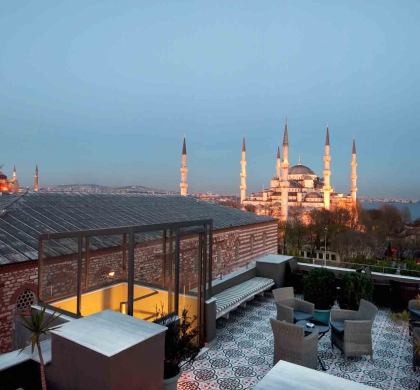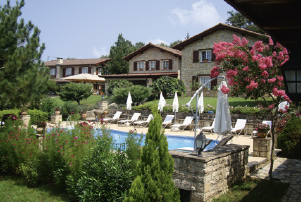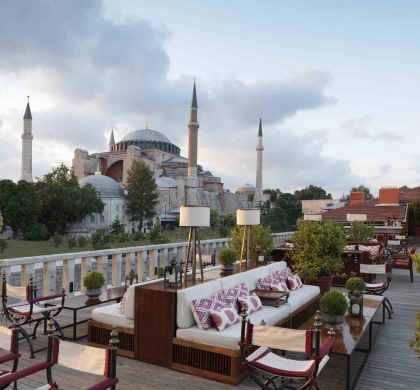Buy or gift a digital subscription and get access to the complete digital archive of every issue for just £18.99 / $23.99 / €21.99 a year.
Buy/gift a digital subscription Login to the Digital EditionIstanbul’s mystique has long captivated writers, but, as an exhibition reveals, not all care to visit. Maureen Freely gives us chapter and verse
'How the world sees us.' Time was when a Turkish newspaper was not a newspaper without at least one article bearing this headline, confirming that the Western world saw in Turkey nothing but reflections of its own prejudices. All was backward, violent and inscrutable. Any story suggesting otherwise was not a story fit to print. If the Western gaze is no longer quite as shaming or wilfully ignorant as it once was, it is thanks in part to Turkey’s rise as a regional or even world power over the past few decades.
Some prejudices refuse to die. They are everywhere in evidence in The Story Unfolds in Istanbul, which charts five centuries of Istanbul in Western fiction, but here, at least, they do not have the last word, for in this captivating, eye-opening exhibition, the tables are turned. To roam the Meşher gallery’s several floors is to gaze back at the West, wondering at the power that this city has exerted over the Western imagination since the earliest years of Ottoman rule.
The almost 300 works on display come to us from Ömer Koç’s vast library of works on the Ottoman Empire, through the imaginative intervention of his librarian, Sven Becker, formerly head of Books & Manuscripts at Christie’s New York. While compiling that library’s 1,600 travel narratives by Western visitors, he could not help but notice how many of their authors had never set foot in the city, and how often these authors’ books went on to become required reading for those who actually made the visit, so that by the time these genuine travellers reached Constantinople, the city was “already a character in a more-or-less crystallised story”. Intrigued by the potency of fiction dressed as truth, Becker turned his attention to those works of prose and poetry in the Ömer Koç library that made no claim to being factual.
In the library catalogue Istanbul in the Western Literary Imagination, he describes in succinct detail what is to be found between their covers. While never passing judgement on their authors or their politically tinted glasses, he takes care to point out the singularity of each work. The chronological ordering does still invite a few passing thoughts on Orientalism in practice, so amply illustrated by their gorgeously sensational covers. These have pride of place in the Meşher exhibition, and a less imaginative curation might have left them to speak for themselves. Şeyda Çetin and Ebru Esra Satıcı are to be congratulated for using them only as their starting points, the seeds from which many tendrils grew.
The Mask of Dimitrios, for example. It was the first of three thrillers that Eric Ambler, father of the modern thriller, set in Istanbul (though in time-honoured fashion, he never made it there himself). The city in these pages is only a backdrop, occasionally described. In the film version, starring Peter Lorre and Sydney Greenstreet, it is not even that. All we see of 1930s Istanbul are its darkly lit interiors and the shadows cast by Colonel Haki, the sinister chief of the secret police, who makes a second appearance in Ambler’s next Istanbul thriller, Journey into Fear, played on this occasion by Orson Welles.
Ambler’s third Istanbul novel, The Light of Day, was the inspiration for Topkapi, one of the great box-office hits of the early 1960s. Though the film posters adorning the exhibition’s Ambler windows change in style with each new era, they converse easily with the posters for From Russia with Love in the Ian Fleming window, and the more distantly placed cover art for Graham Greene’s Stamboul Train, Agatha Christie’s Murder on the Orient Express, Claude Farrère’s L’homme qui assassina and Georges Simenon’s Les clients d’Avrenos. Together they speak of a destination of dangerous consequence. As such, they acknowledge the lasting power of Orientalist tropes, while inviting us to move beyond them, to ask what else might be going on.
This, the curators tell me, is one reason why they chose to mix up the centuries, forms and artistic categories, and why so many of their displays contain watercolours and engravings alongside first editions, and satirical maps alongside puzzles, comics, porcelain figurines and painted artillery shells. They offer each arrangement as a window to another world. They hope that by breaking up the usual order of things, they will suggest new patterns that might, in turn, prompt new questions. Why, for example, are sultans in Western illustrations always so fat? Why are there so many captive women languishing until liberated by Western men? Is the harem endlessly fascinating because its doors are closed to the West, or because its romancers feel free to imagine the lascivious worst, knowing as they do that their home audiences are unlikely to contradict them? If we despair at the liberties some authors allow themselves, are we saying that fiction must always have some basis in fact?
In her preface to Ibrahim ou l’illustre Bassa, the much-admired 17th-century novel starring a lovesick Sultan Süleyman, Madeleine de Scudéry put forward the idea that a novel should aspire to vraisemblance, blending facts into its fictions to create a semblance of truth. Writing in the 19th century from our side of the Channel, Thomas Hope seems to have heeded her advice, drawing from his own adventures in Anastasius, whose Greek-born hero converts to Islam to live and fight with the Ottomans. We shall never know if Hope’s real-life forays into the Ottoman world were as fabulous as the vraisemblant adventures he invented for his hero. Just as we shall never know if Byron was as successful with Constantinople’s women as Don Juan was during his brief spell in the city as a slave – though we do know that Byron had a few facts to weave into the story, having spent two months in the city after swimming across (or just claiming to have swum across) the Hellespont.
The Constantinople to which Jules Verne sent the stubborn Kéraban-le-têtu is, by contrast, entirely imaginary, as is the city to which Rudolf Erich Raspe dispatched his preposterous Baron Munchausen. Voltaire never visited the city either – though he had apparently wished to see it, and some say he would have certainly made the trip in 1740, had political controversy not detained him. It was outside Constantinople, after all, that an honest Turk taught Candide how to cultivate his own garden.
Voltaire was far from the only European author to find things to admire in the Ottoman way of life. But with the teeny-tiny advances made by women in Western societies in the 19th century came a growing – some might say prurient – interest in Constantinople’s captive women. How to get past those truth-veiling doors to witness the horrors inside? How to give fictions the semblance of veiled truth? For Adrienne Piazzi, the only marketable option was a pseudonym. She wrote under the name of Leïla Hanoum to give the impression that her 19th-century harem stories were written by an Ottoman woman with inside knowledge. In the early 20th century, Pierre Loti took dissimulation to new levels with Aziyadé, drawn, he said, from the diaries he kept during a tragic love affair with a harem escapee that he almost certainly invented. In Les Désenchantées, his next foray into Harem Lit, he went out of his way to present himself as a writer of pure fiction, though it later turned out that he’d based his story on accounts fed to him by real women who were telling him the lies he (and his readers) most wished to hear.
It is hardly a surprise that his Ottoman contemporaries took a dim view of him. The great and greatly offended Nâzım Hikmet went so far as to denigrate him in a poem entitled ‘Şarlatan Piyer Loti’. As I wandered through the exhibition I, too, had to ask why exactly the Pierre Lotis of this world were so intent on sexualising every inch of the city. Were they perhaps projecting dreams and desires they dared not name? Were they just a bit jealous of the fun they thought they were missing, behind those tightly shut doors? Did they think the Ottomans knew more than they did about matters amorous and sensuous? And even if they did, was that necessarily a bad thing?
If Virginia Woolf chose Constantinople for Orlando’s metamorphosis from man to woman, she was not so much affirming its reputation for gender fluidity as playing with it. Like Yeats in ‘Sailing to Byzantium’, she was using the city as a metaphor. Her eyes were on her own time and culture. She understood the conceit. She had nothing to say about the city she’d viewed so fleetingly from a window at the Pera Palace. She was interested in Constantinople as an idea.
Because that is what it had always been, in the realm of Western letters if nowhere else. If modern-day Istanbul has inherited the mantle, it could well be because Western chroniclers have only ever read each other’s Istanbuls for the better part of a century, as there was no serious effort to translate its Turkish chroniclers until very recently. It will be interesting to see what impression they make on the Western imagination, now that they are coming into English and other European languages. But it is all happening very slowly, and that is a problem for those writing Istanbul in Western languages today. It is, at least for those of us who have done more than view the city from a hotel window, or darkly through a distant glass.
For in the eyes of Western publishers, Istanbul is still a maze of Oriental mystery, as we who pick up our pens after long years here are only too aware. We each have our own ways of upsetting their expectations. Contrarian that I am, I’ve found pleasure in refusing to furnish the Eastern exotica that so many of my publishers still pine for. Respectful foreigner that I also am, I specialise in narrators with Western passports who misunderstand almost everything they see.
But perhaps I’ve been too careful. I wish I could be as playful as Jason Goodwin and his 19th-century eunuch sleuth. I wish I could write a historical novel as confident of its research as Jenny White’s. I wish, most of all, that I could write my cake and eat it too, as Andrew Finkel has done in The Adventure of the Second Wife, a glorious confection that blends present-day Istanbul with end-of-empire Constantinople, and present-day London with the London of Sherlock Holmes, drawing its characters from history as well as Arthur Conan Doyle to chase a crime that never happened. It is both a parody of a Victorian adventure story and the real thing. An exercise in vraisemblance and a masterclass in disenchantment. A final outing for Constantinople the idea, in an Istanbul lived and loved.
It is a fitting last entry for Sven Becker’s catalogue. We must thank him, therefore, for having chosen February 2024 as his endpoint. For had he stretched to the end of the year, he might have been obliged to finish with AE Goldin’s Murder in Constantinople, a hash-up of Oriental tropes so wild that I couldn’t help but wonder if it was intentional. It takes place during the Crimean War – or does it? It is too full of anachronisms to know for sure. Or are we to read it as science fiction? The hero would have to be a time traveller to be dashing from one side of the Bosphorus to the other in the times reported. Did the author ever bother to visit the city, and if he didn’t, did he at least seek out a few old photographs to get a feel of the place, and if he did, were they so very grainy as to make its minarets look like spires? Is his hero served quinoa and tahini near the mouth of the Black Sea in 1854 because the author enjoyed that dish at an upscale nouveau Turkish restaurant in London sometime last year? Did he care at all about verisimilitude, seeing that his readers were unlikely to care either?
We shall never know, I fear. We can only heave a great sigh. Or laugh.
Maureen Freely is the translator of five books by Orhan Pamuk and more than
a dozen 20th-century classics. Four of her eight novels are set in Istanbul
● The Story Unfolds in Istanbul is at Meşher, Beyoğlu, Istanbul, until January 18, 2026; mesher.org/en.
The mountain where Endymion still sleeps, by Ross Atabey and Rupert Scott
Faik Şenol’s camera transports Clara Robins back to Thirties Istanbul




Cornucopia works in partnership with the digital publishing platform Exact Editions to offer individual and institutional subscribers unlimited access to a searchable archive of fascinating back issues and every newly published issue. The digital edition of Cornucopia is available cross-platform on web, iOS and Android and offers a comprehensive search function, allowing the title’s cultural content to be delved into at the touch of a button.
Digital Subscription: £18.99 / $23.99 (1 year)
Subscribe now